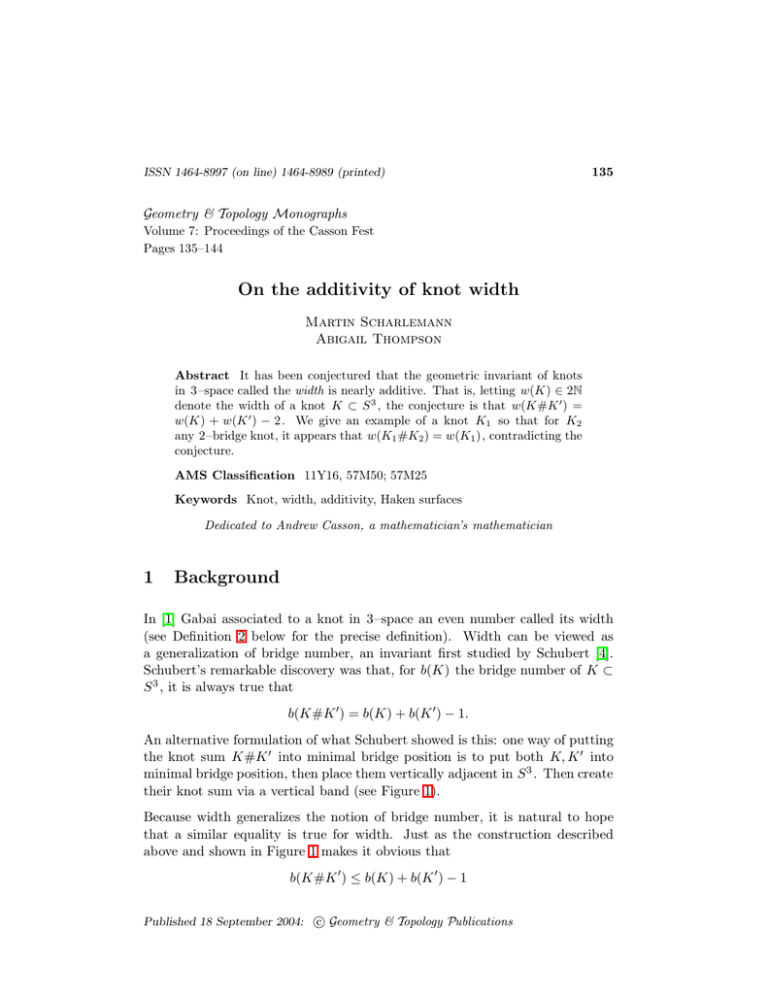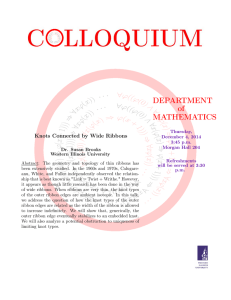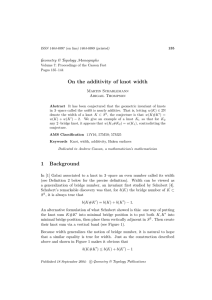On the additivity of knot width Geometry & Topology Monographs Martin Scharlemann
advertisement

ISSN 1464-8997 (on line) 1464-8989 (printed)
135
Geometry & Topology Monographs
Volume 7: Proceedings of the Casson Fest
Pages 135–144
On the additivity of knot width
Martin Scharlemann
Abigail Thompson
Abstract It has been conjectured that the geometric invariant of knots
in 3–space called the width is nearly additive. That is, letting w(K) ∈ 2N
denote the width of a knot K ⊂ S 3 , the conjecture is that w(K#K ′ ) =
w(K) + w(K ′ ) − 2. We give an example of a knot K1 so that for K2
any 2–bridge knot, it appears that w(K1 #K2 ) = w(K1 ), contradicting the
conjecture.
AMS Classification 11Y16, 57M50; 57M25
Keywords Knot, width, additivity, Haken surfaces
Dedicated to Andrew Casson, a mathematician’s mathematician
1
Background
In [1] Gabai associated to a knot in 3–space an even number called its width
(see Definition 2 below for the precise definition). Width can be viewed as
a generalization of bridge number, an invariant first studied by Schubert [4].
Schubert’s remarkable discovery was that, for b(K) the bridge number of K ⊂
S 3 , it is always true that
b(K#K ′ ) = b(K) + b(K ′ ) − 1.
An alternative formulation of what Schubert showed is this: one way of putting
the knot sum K#K ′ into minimal bridge position is to put both K, K ′ into
minimal bridge position, then place them vertically adjacent in S 3 . Then create
their knot sum via a vertical band (see Figure 1).
Because width generalizes the notion of bridge number, it is natural to hope
that a similar equality is true for width. Just as the construction described
above and shown in Figure 1 makes it obvious that
b(K#K ′ ) ≤ b(K) + b(K ′ ) − 1
c Geometry & Topology Publications
Published 18 September 2004: Martin Scharlemann and Abigail Thompson
136
(Schubert’s deep contribution is the proof of the reverse inequality, see [5]), it
also shows that knot width w satisfies the inequality
w(K#K ′ ) ≤ w(K) + w(K ′ ) − 2.
That is, the resulting presentation of K#K ′ has width precisely equal to
w(K) + w(K ′ ) − 2. The inequality reflects uncertainty over whether this presentation is of minimal width (that is, thin) among all possible presentations
for K#K ′ . This suggests the following
Conjecture 1 For all knots K, K ′ ⊂ S 3 ,
w(K#K ′ ) = w(K) + w(K ′ ) − 2.
K
K′
Figure 1
Beyond the analogy with bridge number, and the ease of the inequality in
one direction, there are two pieces of evidence for Conjecture 1. One piece of
evidence is the proof in [2] that the conjecture is true for knots that are small,
that is, knots which have no closed essential surfaces in their complements. A
second but weaker piece of evidence is the proof in [3] that in any case,
w(K#K ′ ) ≥ max{w(K), w(K ′ )}.
This shows that at least some inequality in the reverse direction is true.
The aim here is to present an example of a knot (actually a family of knots)
K1 which appears to have the property that
w(K1 #K2 ) = w(K1 )
Geometry & Topology Monographs, Volume 7 (2004)
On the additivity of knot width
137
whenever K2 is a 2–bridge knot. Since the width of a 2–bridge knot is 8, this
would be a counterexample to Conjecture 1. Although we are not able to prove
this equality, the construction of K1 is so flexible that the example does seem
to undercut any hope that the conjecture is true. Only the absence so far of
a good method to prove that our presentation of the knot (family) K1 is the
presentation of least width stands in the way of a complete proof that at least
some of these knots are counterexamples to Conjecture 1.
2
The example
The example K1 is shown in Figure 2. It is actually a family of examples,
because specific braids inside of boxes are not specified; the point will be that,
in search of an example, the number of critical points r can be made arbitrarily
high and the braids themselves be made arbitrarily complicated.
r maxima
thick
braid
thin
braid
thick
braid
thin
braid
thick
r minima
Figure 2
Figure 3 shows an imbedding of K1 #(trefoil) into S 3 ; a decomposing sphere
Geometry & Topology Monographs, Volume 7 (2004)
138
Martin Scharlemann and Abigail Thompson
is shown in the figure. Note that the width of the presentations of K1 and
K1 #(trefoil) with respect to the vertical height function are the same, since
there is an obvious level-preserving reimbedding of one to the other. (The
construction of K1 was inspired by the extensive use of level-preserving reimbeddings in [3].) Moreover, the only property of the trefoil knot that is used
in the level-preserving reimbedding is the fact that it is 2–bridge — any other
2–bridge knot would do.
Figure 3
If we knew that the given presentation of the knot K1 is thin (that is, of minimal
width) we would be done. We do not yet know a full proof of this, but cite two
pieces of evidence:
First of all, the braids in the four braid boxes of Figure 2 may be made very
complicated so that the number of critical points of a plane sweeping across the
boxes in any direction except the vertical will have a large number of critical
points and arbitrarily high width. Although this does not obviously rule out
the possibility of more complicated sweep-outs, it seems very likely that with
sufficiently complicated braids in place a sweep-out can only be thin for the
whole knot if the sweep-out passes through these braid-boxes vertically, that
is as horizontal planes, just as in the given presentation. (This is a stronger
requirement than merely ensuring that the tangles within the braid boxes are
Geometry & Topology Monographs, Volume 7 (2004)
On the additivity of knot width
139
thin.) Once this is ensured, the order in which the sweep-out passes through
each tangle could be compared to the given order; alternative orders, such as
the order shown in Figure 4, will give rise to greater width (see calculation
below) as long as r ≥ 4.
This second but indirect bit of evidence that K1 is thin is this: According to
Schubert’s theorem, there is a presentation of K1 with lower bridge number
than that of K1 #(trefoil) shown in Figure 3. But the Figure 3 presentation
has the same bridge number as the presentation of K1 shown in Figure 2.
Given that width is a generalization of bridge number, we ought to check that
the presentation that lowers bridge number from that in Figure 2 does not also
lower width. Figure 4 shows a presentation of K1 that has lower bridge number
than the original presentation, shown in Figure 2. But in fact the presentation
of K1 in Figure 4 is not as thin as that in Figure 2.
braid
braid
thick
thin
braid
thick
braid
Figure 4
To explicitly compare the widths of the two presentations, recall the definitions
(see [3]):
Geometry & Topology Monographs, Volume 7 (2004)
Martin Scharlemann and Abigail Thompson
140
Definition 2 Let p : S 3 → R be the standard height function and for each
−1 < t < 1 let S t denote the sphere p−1 (t). Let K ⊂ S 3 be a knot in general
position with respect to p and c1 , . . . , cn be the critical values of p|K listed
in increasing order c1 < · · · < cn . Choose r1 , . . . , rn−1 so that ci < ri < ci+1
for
is
P i = 1, .r.i . , n − 1. The width of K with respect to p, denoted by w(K, p),
′ , p)
|K
∩
S
|.
The
width
of
K,
denoted
by
w(K),
is
the
minimum
of
w(K
i
over all knots K ′ isotopic to K . We say that K is in thin position if w(K, p) =
w(K).
The key operational feature of width is that it is reduced if a minimum is pushed
up above a maximum whereas switching the levels of two adjacent minima or
two adjacent maxima has no effect.
There is an easier way to calculate width. For the levels ri described above,
call ri a thin level of K (and the sphere S ri a thin sphere for K ) with respect
to p if ci is a maximum value for p|K and ci+1 is a minimum value for p|K .
Dually ri is a thick level of K (and the sphere S ri a thick sphere for K ) with
respect to p if ci is a minimum value for p|K and ci+1 is a maximum value for
p|K . Since the lowest critical point of p|K is a minimum and the highest is a
maximum, there is one more thick level than thin level.
Lemma 3 Let ri1 , . . . , rik be the thick levels of K and rj1 , . . . , rjk−1 the thin
levels. Set al = | K ∩ S ril | and bl = | K ∩ S rjl |. Then
2w(K) =
k
X
l=1
a2l −
k−1
X
b2l .
l=1
Proof See [3].
Now apply this formula to the presentations of K1 given in Figures 2 and 4,
with thick and thin spheres (appearing as planes) noted in the figures. The
former has width
4(r + 1)2 + 50 − 16 = 2(2r 2 + 4r + 19).
The latter has width
4(r + 2)2 − 8 = 2(2r 2 + 8r + 4).
So as long as r ≥ 4 ⇒ 8r + 4 > 4r + 19 the presentation of K1 in Figure 2 is
thinner.
Geometry & Topology Monographs, Volume 7 (2004)
On the additivity of knot width
3
141
Higher bridge number
It is reasonable to ask whether likely counterexamples to the conjecture are
limited to knots, such as those above, whose width is unchanged by adding
2–bridge knots. After all, 2–bridge knots often play a special role in knot
theory. Almost certainly the answer is no; in this section we briefly note how
a 3–bridge counterexample might be constructed. In principle the same ideas
should work with arbitrary bridge number, though this would appear to be
increasingly difficult to demonstrate.
r3
r2
s3
r1
s1
s2
s2
r1
s3
r2
r3
Figure 5
Consider a knot K3 of the form described in Figure 5. The notation ri denotes
the number of strands of the part of the knot that lies inside the “braid-box”,
that is, twice the number of maxima appearing above the upper boxes (respectively, below the lower boxes). The notation si refers to the number of
parallel strands between the boxes. The thin unmarked strand represents a
single strand. We have earlier seen that the knot K1 in Figure 2 can be added
to any 2–bridge knot, without apparently affecting its width, by reimbedding
it in a level-preserving way as a satellite of any 2–bridge knot. In the same
way, the knot K3 in Figure 5 can be reimbedded in a level-preserving way as a
satellite of any 3–bridge knot K4 . This reimbedding gives a presentation of the
sum K3 #K4 that has the same width as the original presentation of K3 . So if
the given presentation of K3 is thin, we have a counterexample to Conjecture
1 in which one of the summand knots is the specific knot K3 and the other is
Geometry & Topology Monographs, Volume 7 (2004)
Martin Scharlemann and Abigail Thompson
142
any 3–bridge knot.
Of course there is still the difficulty of showing that the presentation of K3 in
Figure 5 is thin. But again the flexibility in how the braid-boxes are filled in
suggests that filling in with complicated braids will force any thin presentation
also to sweep across the braid boxes vertically. So a thin presentation is likely
to preserve the braid-box structure. It is perhaps less plausible here than in the
case of K1 that a presentation which preserves the braid-box structure cannot
be thinner than the original presentation; indeed, an example of a significantly
different presentation of K3 that preserves the braid-box structure is given in
Figure 6.
r3
r1
r2
r2
r1
r3
Figure 6
However, it is straightforward (though not particularly easy) to show that with
appropriate choice of ri , sj the first presentation is thinner than the second. A
comparison of the two widths is unaffected by the size of r3 . In addition, so
long as we
• take the other values of ri , sj sufficiently large
• set r1 only minimally larger than s1 + s2
• set s1 > s3 , and, with these numbers set,
• take r2 > s2 + s3 sufficiently high,
then the second presentation of K3 will be wider than the first.
Geometry & Topology Monographs, Volume 7 (2004)
On the additivity of knot width
143
Another typical braid-box preserving presentation of K3 is given in Figure 7.
For this presentation, width can be made arbitrarily high simply by increasing
r3 sufficiently. As already noted, this has no effect on the comparison above,
so ultimately we have values for ri , sj that guarantee the first presentation is
thinnest of the three. Other braid-box preserving presentations are easily dealt
with in a similar manner. As was the case for the 2–bridge examples of the
previous section, there remains the challenge of showing that putting sufficiently
complicated braids into the braid-boxes will guarantee that a thin presentation
will preserve those braid-boxes.
r3
r2
r3
r1
r1
r2
Figure 7
Acknowledgement
This research was partially supported by NSF grants.
References
[1] D Gabai, Foliations and the topology of 3–manifolds. III, J. Differential Geom.
26 (1987) 479–536 MathReview
[2] Y Rieck, E Sedgwick, Thin position for a connected sum of small knots,
Algebr. Geom. Topol. 2 (2002) 297–309 MathReview
Geometry & Topology Monographs, Volume 7 (2004)
144
Martin Scharlemann and Abigail Thompson
[3] M Scharlemann, J Schultens, 3–manifolds with planar presentations and the
width of satellite knots, arXiv:math.GT/0304271
[4] H Schubert, Über eine numerische Knoteninvariante, Math. Z. 61 (1954) 245–
288 MathReview
[5] J Schultens, Additivity of bridge numbers of knots, Math. Proc. Cambridge
Philos. Soc. 135 (2003) 539–544 MathReview
Mathematics Department, University of California
Santa Barbara, CA 93106, USA
and
Mathematics Department, University of California
Davis, CA 95616, USA
Email: mgscharl@math.ucsb.edu, thompson@math.ucdavis.edu
Received: 19 March 2004
Revised: 28 July 2004
Geometry & Topology Monographs, Volume 7 (2004)





